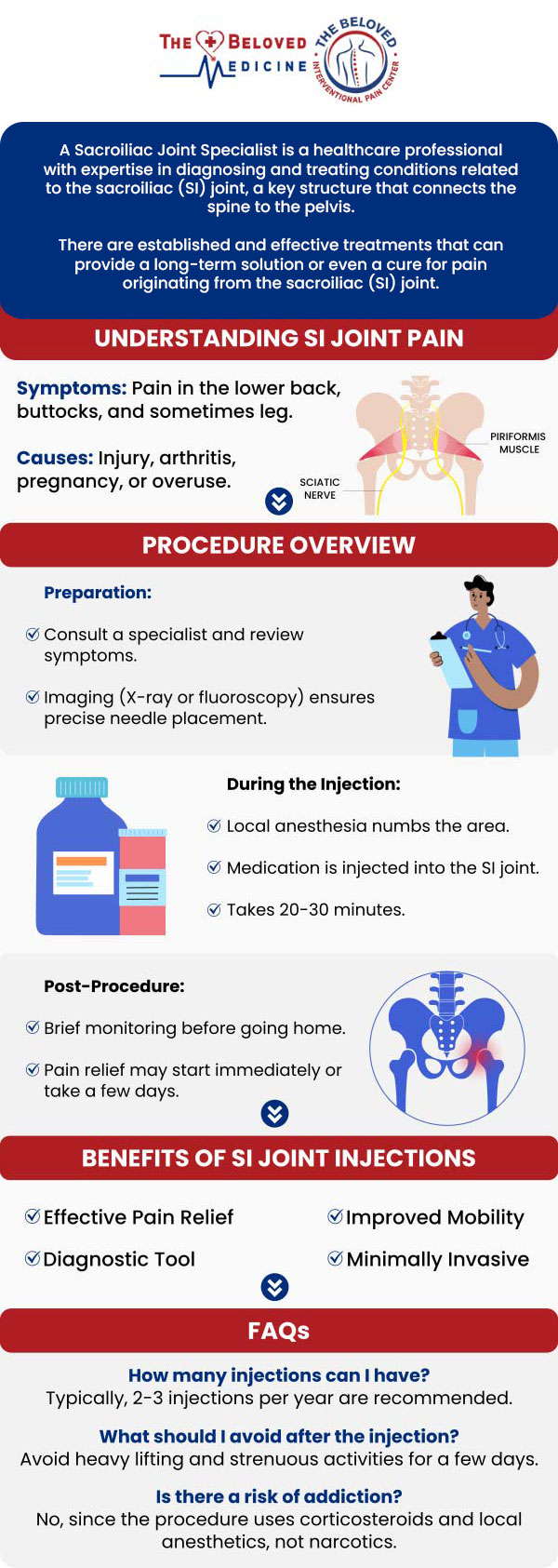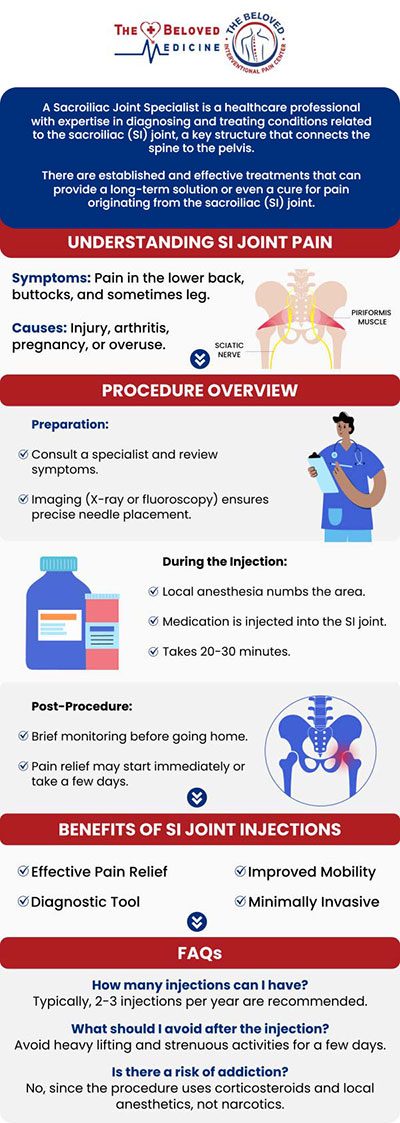Sacroiliac Joint Pain Treatment Specialist in Dallas, TX
At The Beloved Medicine Clinic and Pain Center, Dr. John Melek provides specialized care for sacroiliac (SI) joint pain. Dr. Melek employs a comprehensive approach that includes advanced diagnostics and personalized treatment plans to alleviate pain and improve mobility. For more information, contact us or request an appointment online. We are conveniently located at 7777 Forest Ln Suite A315, Dallas, TX 75230.




Table of Contents:
What is sacroiliac joint pain?
What causes sacroiliac joint pain?
How can I tell if my pain is from the sacroiliac joint?
How is sacroiliac joint pain diagnosed?
At our practice, we specialize in diagnosing and treating conditions such as sacroiliac joint pain, a common yet often overlooked cause of lower back and hip discomfort. The sacroiliac joints connect your lower spine (sacrum) to your pelvis (ilium), playing a crucial role in supporting your upper body and transferring weight and movement from your torso to your legs.
When the sacroiliac joints become inflamed, irritated, or experience abnormal movement, patients typically report pain or stiffness in the lower back, hips, buttocks, or even pain radiating down the legs. You might notice your symptoms worsening after prolonged sitting or standing, climbing stairs, or even performing simple movements such as stepping out of your car.
Our experienced medical team prioritizes accurate diagnosis, as sacroiliac joint pain is often confused with other conditions like lumbar spine issues or hip disorders. We leverage a comprehensive approach, which includes thorough physical examinations, specialized clinical assessments, and advanced imaging techniques such as X-rays, MRIs, or CT scans as necessary, to pinpoint the root cause of your discomfort.
At our practice, we specialize in accurately diagnosing and effectively treating sacroiliac joint pain to help patients regain comfort and mobility. Sacroiliac joint dysfunction typically arises from inflammation or misalignment of the joints connecting your pelvis to the lower spine, and our clinic provides comprehensive solutions tailored specifically to each patient’s needs.
Common causes we regularly address include:
● Injury or trauma: Accidents, falls, or direct impacts to the lower back or pelvic area can injure these joints, causing inflammation and chronic pain. Our specialists perform detailed evaluations to develop personalized recovery plans.
● Degenerative arthritis: Osteoarthritis can result in cartilage deterioration within the sacroiliac joints, causing persistent stiffness and discomfort. We offer advanced, minimally invasive treatment options to relieve pain and restore joint function.
● Pregnancy-related changes: Hormonal fluctuations during pregnancy may loosen ligaments surrounding the sacroiliac joints, increasing instability and pain both during and after pregnancy. Our team provides safe, targeted therapies to help patients manage and alleviate pregnancy-related joint pain.
● Poor posture and gait abnormalities: Uneven leg lengths, poor posture, or abnormal walking patterns often place undue stress on sacroiliac joints. Our specialists utilize advanced diagnostic methods and personalized physical therapy programs to correct these imbalances.
Through comprehensive evaluations that include thorough medical history assessments, detailed physical examinations, and advanced diagnostic imaging technologies, our medical professionals provide accurate diagnoses and effective, individualized treatment plans. Our goal is to help patients overcome sacroiliac joint pain and return to active, comfortable lives.
Determining whether your pain originates from the sacroiliac (SI) joint can sometimes be challenging, as symptoms often overlap with other lower back or hip conditions. At our practice, we specialize in accurately diagnosing and effectively treating SI joint dysfunction. Typically, SI joint pain presents itself in the lower back region—particularly on one side—and may radiate into the buttocks, hips, groin, or thighs. Patients often describe this pain as sharp, dull, or aching, intensifying during specific movements such as standing up from a seated position, climbing stairs, or turning in bed.
A common indicator of SI joint dysfunction is increased pain during activities that put extra stress on the joint, such as prolonged standing, walking, or bearing weight. Many individuals find relief when lying down or resting, with symptoms improving after adjustments in posture or position.
One highly effective method we use to confirm SI joint pain is targeted diagnostic injections. If our specialists suspect your SI joint is the source of your discomfort, we may perform a precise injection of anesthetic directly into the joint under imaging guidance. If this injection promptly alleviates your pain, it provides strong evidence of SI joint involvement, allowing us to develop a personalized treatment plan tailored to your needs.
At our practice, we specialize in effectively diagnosing and treating sacroiliac (SI) joint pain to help patients regain comfort and mobility. Our experienced medical providers begin every evaluation by carefully reviewing your detailed medical history and conducting a thorough physical examination. During your visit, we will listen closely as you describe your symptoms, noting the location, intensity, and specific activities or movements that trigger or alleviate your discomfort.
To accurately identify sacroiliac joint issues, we perform specialized physical tests and maneuvers that apply gentle pressure or stress to the SI joint. These tests help us reproduce your pain symptoms, confirming the SI joint as the source of your discomfort and guiding our next steps.
Additionally, our practice leverages advanced imaging techniques as part of our comprehensive diagnostic approach. X-rays help us rule out other potential conditions such as fractures or arthritis, while Magnetic Resonance Imaging (MRI) or Computed Tomography (CT) scans offer detailed views of soft tissues, joints, and bones, allowing us to assess inflammation, degeneration, or structural abnormalities within the sacroiliac joint.
At our practice, diagnosing sacroiliac joint pain involves a personalized combination of clinical evaluation, advanced imaging studies, and targeted diagnostic injections. This comprehensive approach ensures accurate identification of the underlying cause of your pain, providing the foundation for effective, individualized treatment plans designed to restore your quality of life. For more information, contact us or request an appointment online. We are conveniently located at 7777 Forest Ln Suite A315, Dallas, TX 75230. We serve patients from Dallas TX, Plano TX, Addison TX, Richardson TX, Garland TX, and surrounding areas.





